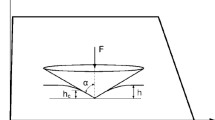Abstract
This work probes a hypothesis for predicting a critical stress associated with of environmental stress cracking (ESC). The hypothesis is based on a thermodynamic criterion for localized swelling induced by stress on the polymer. The surface-active liquids chosen for study are oleic acid and dibutyl phthalate and the polymer is polycarbonate (PC). An experimental technique involving contact angle measurements of a sessile drop as a function of stress is used to probe the hypothesis. A new method for measuring contact angle using refraction is also introduced. No significant change in contact angle as function of stress is observed in either system, though the kinetics of craze initiation and inelastic strain at craze initiation do show a shift in response to stress at levels similar to those predicted by the hypothesis.












Similar content being viewed by others
References
Kambour RP (1973) Macromol Rev 7:1
Raman A, Farris RJ, Lesser AJ (2003) J App Polymer Sci 88:550
Gent AN (1970) J Mater Sci 5:925
Mai YW (1986) J Mater Sci 21:904
Yee AF (2000) Macromolecules 33:1338
McGrath JE Parvatareddy H, Dillard JG, Dillard DA (1999) J Adhesion 69:83
de Gennes PG (1985) Rev Mod Physics 57:827
Kwok DY, Neumann AW (1999) In: Surface characterization methods; surfactant science series, vol. 87. Marcel Dekker, New York, NY, p 37
Langmuir I (1937) J Amer Chem Soc 59:2400
Rondelez F, Allain C, Ausserre D (1985) J Colloid Interface Sci 107:5
Flory PJ (1953) In: Principles of polymer chemistry. Cornell University Press, Ithaca, NY, p 576
Gent AN (1989) J Polaymer Sci Part B 27:893
Treloar LRG (1950) Trans Faraday Soc 46:783
Treloar LRG (1972) Polymer 13:195
Treloar LRG (1972) Polymer 13:203
Mark JE (1999) Polymer data handbook Oxford Univ. Press New York, NY p 363
Barton AFM (1983) In: CRC handbook of solubility parameters and other cohesion parameters. CRC Press, Boca Raton, FL
Mandel J (1964) In: The statistical analysis of experimental data. John Wiley & Sons, New York, NY, p 72
Arnold JC (1995) J Mater Sci 30:655
Acknowledgements
We would like to acknowledge the generous support given this work by the Materials Research Science & Engineering Center on Polymers at the University of Massachusetts (MRSEC) and Cluster M of the Center for University of Massachusetts-Industry Research in Polymers (CUMIRP). Cluster M member companies include: Atofina, Essilor USA, Henckel Loctite, International Paper and Meadewestvaco.
Author information
Authors and Affiliations
Corresponding author
Rights and permissions
About this article
Cite this article
Walsh, P.J., Lesser, A.J. Evaluating environmental stress cracking thresholds by contact angle measurements. J Mater Sci 42, 5835–5844 (2007). https://doi.org/10.1007/s10853-006-1390-z
Received:
Accepted:
Published:
Issue Date:
DOI: https://doi.org/10.1007/s10853-006-1390-z



